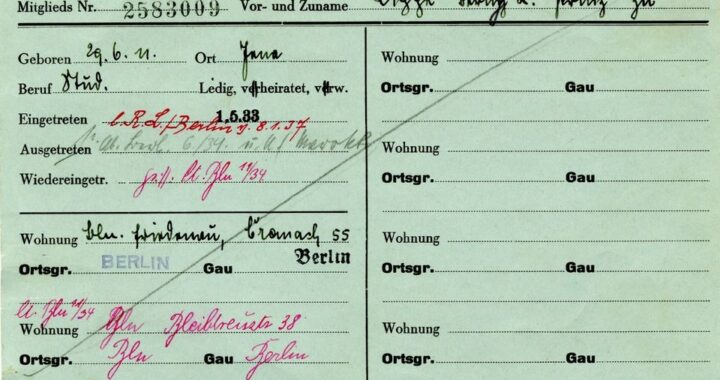The present fuss says a lot about the complete lack of historical knowledge among many media editors. But it is not just that: everyone seems to have an opinion about Prince Bernhard van Lippe-Biesterfeld (1911-2004), but that this opinion is partly or largely based on lies and fabrications that the prince lavishly threw around, is not realised by many.
A brief factual account
Originally from Germany, the prince married Dutch Crown Princess Juliana on 7 January 1937. She was queen of the Netherlands from 1948 until 1980. During the marriage, Bernhard indulged in intrigues, extramarital affairs and corruption, mostly covered up by successive cabinets.
Thursday, December 17, 1936. An article in the weekly De Tribune reveals that the Dutch population knew that Prince Bernhard had been a member of the SS.
From Dutch newspaper reports 1933-1936, it is crystal clear that people in the Netherlands at the time knew that in 1925 “the SS (Schutzstaffel) had been formed as a special bodyguard for the leaders of the NSDAP”. In other words: anyone who was a member of the SS in the first half of the 1930s was, with a probability bordering on certainty, also a member of the NSDAP.
That the SS was responsible for the hundreds of murders in the so-called Night of the Long Knives, 30 June 1934, became known worldwide in the second half of 1934. Ditto the fact that the SS run and ruled the concentration camps. That things were not exactly pleasant there even then could be read by the average Dutchman in the daily newspapers and many other publications.
After the German invasion, May 10 1940, the Dutch royal family fled to the United Kingdom. Bernhard spent the war basically doing nothing but partying and parading in fancy uniforms. He flew one combat mission – as a passenger – aboard a bomber of the US 8th Airforce, June 21, 1944 above northwest France. He wasn’t trusted by the UK intelligence services, and wasn’t taken seriously by the Allied commanders.
In 1948, the Americans informed the Dutch government that Bernhard’s name appeared on a list of former NSDAP members. The government’s response is rather baffling: it attempts to remove Bernhard’s name from that list. That this happened was revealed by historians Gerard Aalders and Coen Hilbrink in 1996. They then show copies of documents proving Bernhard’s membership.
Bernhard’s concoctions
In the 1950s and 1960s, Bernhard bragged to his biographers (or rather hagiographers) that he had also been a member of the SA. So-called because otherwise he could not study or take exams. Which is nonsense: even Jewish students were admitted to universities in Nazi Germany until 1938.
It is said that in the 1930s, just about all Germans were members of the NSDAP. Also nonsense: that percentage was around 10-15%. Making a career in Nazi Germany was possible even without party membership.
Annejet van der Zijl’s excellent Bernhard biography, published in 2010 and often reprinted, describes all this in detail. The picture she paints of Bernhard is that of a money and prestige hungry opportunist and good-for-nothing, who, before marrying Juliana in 1937, had been a convinced National Socialist.
In the Second World War, he played no role of any importance – except that of looter, party-goer and adulterer. And what he did afterwards does not exactly reassure either.
That successive cabinets have known about all this is plausible. And nobody needs to have any illusions about why they tried to cover up all Bernhard’s affairs as much as possible: after all, the royal family had to be protected.
Further investigation?
There are these days calls in the media for further official investigations. Into Bernhard and into the role of the Dutch cabinets that have covered his deception over the years.
But why is such an investigation necessary? All those directly involved are dead or of very high age. We pretty much know what and why everything happened. Such an enquiry is an exercise in futility.
Even stranger are the voices calling for King Willem Alexander to answer for his grandfather’s behaviour. Why? Neither he nor other descendants are in any way responsible for Prince Bernhard’s misdeeds. Well considered, they, who grew up thinking their father and grandfather was bona fide, are the biggest victims of the man’s lies.
And what about renaming streets named after Prince Bernhard? That’s a bad idea: it costs an unnecessary amount of money and the past won’t be changed by doing so. It is better that through these tainted names “the Dutch gullible people” (dixit William the Silent, Prince of Orange, 1533-1584) are permanently reminded of the rogue that Bernhard was, on the one hand. And on the other hand his name shows the idiocy of monarchies.
With thanks to Jaap van den Born, who pointed me to the 1936 De Tribune article.
Sources
Gerard Aalders & Coen Hilbrink. De affaire Sanders. Spionage en intriges in herrijzend Nederland. Sdu Uitgevers, Den Haag, 1996.
Flip Maarschalkerweerd. De achterbklijvers. Balans, Amsterdam, 2023.
NN. Bernhard had lidmaatschapskaart NSDAP in eigen archief. NOS Nieuws, Hilversum, 04-10-2023.
NN. De sturm-abteilung Hitler’s S.A. Provinciale Overijsselsche en Zwolsche Courant. Zwolle, 11-07-1934.
NN. Nacht van de lange messen. Duitslandinstituut, Amsterdam, [s.a.].
NN. Oranje en de SDAP. De Tribune, Amsterdam, 17-12-1936.
NN. SA en de SS, paramilitaire organisaties van de NSDAP. Anne Frank Stichting, Amsterdam, [ca. 2016].
G. Nypels. Wat de weensche pers weet te vertellen. Onthullingen van regeerings- en nazi-organen over Hitlers actie. Algemeen Handelsblad, Amsterdam, 06-07-1934.
Marja Verburg. ‘Onbewust NSDAP-lidmaatschap is een mythe’. Interview met historicus Malte Herwig. Duitsland Instituut, Amsterdam, 14-01-2015.
Annejet van der Zijl. Bernhard. Een verborgen geschiedenis. Querido, Amsterdam – Antwerpen, 2010 (7th edition 2016)
Photo of membership card: Koninklijke Verzamelingen.

